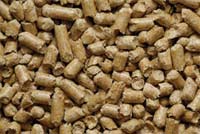A Minnesota start-up company says it’s invented and successfully tested a new biomass briquette that could become to coal what ethanol has been to gasoline.
Renewafuel, a two-year-old subsidiary of Endres Processing in Rosemount, calls them “fuel cubes.” They’re made from a mix of plant materials that include wood, corn stalks and switch grass. Unlike raw biomass, the cubes can be blended with or substituted for coal in existing burners with little or no modifications, the company says.
Like ethanol, burning the fuel cubes creates far less pollution than fossil fuels and producing them has potential to boost rural economies. As with ethanol, too, though, there are concerns about whether harvesting material for the cubes will generate side effects that outweigh their value as an alternative.
“It’s an exciting development, as long as the dense fuel cubes are produced sustainably,” says Todd Reubold, communications director for the Initiative for Renewable Energy and the Environment at the University of Minnesota. “Burning these biomass pellets is beneficial to the environment, but you have to look at the whole system.”
Cleveland-Cliffs, an Ohio mining company that owns Hibbing Taconite, Northshore Mining and United Taconite in Minnesota, announced last week it has purchased a 70 percent controlling stake in Renewafuel. It is already using the fuel cubes to heat a pelletizing furnace at one of its Michigan mining facilities and it wants to use them at its Minnesota sites, too, the company said.
James Mennell, a Minneapolis environmental lawyer, and Leon Endres, owner of Endres Processing, started working on the fuel cubes a couple of years ago. Mennell learned the industry from representing many of the region’s ethanol projects, and Endres Processing was already in the business of combining varieties of food waste into livestock feed.
What they came up with was a way to aggregate several types of biomass, from grass to wood and grains to seed hulls, and process it all into dense, coal-like briquettes. The recipe can be adjusted depending on what biomass materials are available in the region where they’re being manufactured or to meet specific requests of customers.
“It’s a little bit of art and a little bit of science to getting different mixes to work,” says Mennell.
The cubes come out similar in size and moisture content, and they produce a consistent amount of heat that’s comparable to what’s created by coal. They generate nearly twice as much energy as other biomass, the company says, putting it on par with coal from the western United States. The cost is competitive with coal in some markets, says Mennell.
When burned, the cubes emit 90 percent less sulfur dioxides, 35 percent less particulate matter and 30 percent less acid gases compared to coal. That’s based on testing the company ran at the University of Iowa with supervision by the U.S. Environmental Protection Agency.
The company says burning the fuel cubes doesn’t contribute to global warming because the carbon emitted was only recently stored in the plant material. Coal and gas burning, on the other hand, release carbon into the atmosphere that had been stored underground for centuries and was no longer part of the natural balance.
That’s not necessarily true, says Matt Norton, forestry advocate for the Minnesota Center for Environmental Advocacy. He’s skeptical about the sources Renewafuel will use to harvest material for its cubes. If it relies too much on wood, it could rachet up pressure to clear forests, causing the release of carbon that had been stored there for decades.
“My fear is that wood is there and it’s ready, and it’s what they’re going to turn to,” says Norton. “And if they start consuming wood, then the claims they make with regard to carbon neutrality are not borne out. If they start consuming prairie grasses, hats off to them. This could be something we would support in a big way.”
Norton is part of a subgroup of Clean Energy Minnesota that’s trying to come up with a system for scoring biomass fuels based on things like how much net energy they produce, how much carbon they divert from the atmosphere, and how else they affect the economy and environment. It’s not yet clear whether Renewafuel’s project would rank high or low, he says.
Reubold says he expects questions will arise about whether energy is the best use for materials like wood fibers. The use of corn for ethanol fuel instead of food has generated debate and claims it is causing rising food prices. Increasing the use of wood for biomass energy could create competition and higher material prices for other industries.
But Renewafuel’s fuel cube appears to be an important breakthrough, Reubold says, because it allows companies to use biomass without building new facilities.
“The challenge is breaking into a market that’s dominated by coal,” says Reubold. “What this does is it gets a foot in the door for using new forms of biomass to produce bioenergy.”


